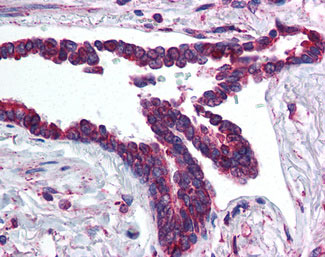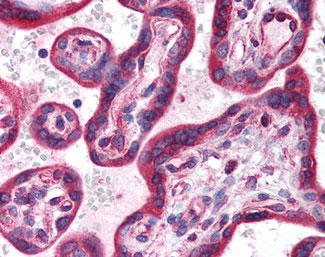HIF3A / HIF3-Alpha Antibody (aa581-592)
Rabbit Polyclonal Antibody
- SPECIFICATION
- CITATIONS
- PROTOCOLS
- BACKGROUND

Application
| WB, IHC-P, IF, E |
|---|---|
| Primary Accession | Q9Y2N7 |
| Reactivity | Human, Mouse |
| Host | Rabbit |
| Clonality | Polyclonal |
| Calculated MW | 72kDa |
| Dilution | ELISA (1:14000-1:80000), IHC-P (5 µg/ml), WB (1:100-1:8000) |
| Gene ID | 64344 |
|---|---|
| Other Names | Hypoxia-inducible factor 3-alpha, HIF-3-alpha, HIF3-alpha, Basic-helix-loop-helix-PAS protein MOP7, Class E basic helix-loop-helix protein 17, bHLHe17, HIF3-alpha-1, Inhibitory PAS domain protein, IPAS, Member of PAS protein 7, PAS domain-containing protein 7, HIF3A, BHLHE17, MOP7, PASD7 |
| Target/Specificity | Hif3 a (Hypoxia Inducible Factor). |
| Reconstitution & Storage | Long term: -20°C; Short term: +4°C. Avoid repeat freeze-thaw cycles. |
| Precautions | HIF3A / HIF3-Alpha Antibody (aa581-592) is for research use only and not for use in diagnostic or therapeutic procedures. |
| Name | HIF3A (HGNC:15825) |
|---|---|
| Synonyms | BHLHE17, MOP7, PASD7 |
| Function | Acts as a transcriptional regulator in adaptive response to low oxygen tension. Acts as a regulator of hypoxia-inducible gene expression (PubMed:11573933, PubMed:16126907, PubMed:19694616, PubMed:20416395, PubMed:21069422). Functions as an inhibitor of angiogenesis in hypoxic cells of the cornea. Plays a role in the development of the cardiorespiratory system. May also be involved in apoptosis (By similarity). |
| Cellular Location | Nucleus. Cytoplasm Nucleus speckle {ECO:0000250|UniProtKB:Q0VBL6}. Mitochondrion {ECO:0000250|UniProtKB:Q0VBL6}. Note=In the nuclei of all periportal and perivenous hepatocytes. In the distal perivenous zone, detected in the cytoplasm of the hepatocytes. Shuttles between the nucleus and the cytoplasm in a CRM1-dependent manner. Colocalizes with BAD in the cytoplasm. Colocalizes with EPAS1 and HIF1A in the nucleus and speckles (By similarity). Localized in the cytoplasm and nuclei under normoxia, but increased in the nucleus under hypoxic conditions (PubMed:19694616). Colocalized with HIF1A in kidney tumors (PubMed:19694616). {ECO:0000250|UniProtKB:Q0VBL6, ECO:0000250|UniProtKB:Q9JHS2, ECO:0000269|PubMed:19694616} |
| Tissue Location | Expressed in vascular cells (at protein level) (PubMed:21069422). Expressed in kidney (PubMed:11573933, PubMed:19694616). Expressed in lung epithelial cells (PubMed:16775626) Expressed in endothelial cells (venous and arterial cells from umbilical cord and aortic endothelial cells) and in vascular smooth muscle cells (aorta) (PubMed:21069422). Strongly expressed in the heart, placenta, and skeletal muscle, whereas a weak expression profile was found in the lung, liver, and kidney (PubMed:12538644). Expressed weakly in cell renal cell carcinoma (CC-RCC) compared to normal renal cells (PubMed:16126907). Expression is down-regulated in numerous kidney tumor cells compared to non tumor kidney tissues (PubMed:16126907). Isoform 2 is expressed in heart, placenta, lung, liver, skeletal muscle and pancreas and in numerous cancer cell lines (PubMed:20416395). Isoform 3 and isoform 4 are weakly expressed in heart, placenta, lung, liver, skeletal muscle and pancreas (PubMed:20416395). Isoform 4 is expressed in fetal tissues, such as heart, brain, thymus, lung, liver, skeletal kidney and spleen (PubMed:20416395). Isoform 3 is weakly expressed in fetal tissues, such as liver and kidney (PubMed:20416395). |
| Volume | 50 µl |

Thousands of laboratories across the world have published research that depended on the performance of antibodies from Abcepta to advance their research. Check out links to articles that cite our products in major peer-reviewed journals, organized by research category.
info@abcepta.com, and receive a free "I Love Antibodies" mug.
Provided below are standard protocols that you may find useful for product applications.
Background
Involved in adaptive response to hypoxia. Suppresses hypoxia-inducible expression of HIF1A and EPAS1. Binds to core DNA sequence 5'-TACGTG-3' within the hypoxia response element (HRE) of target gene promoters. The complex HIF3A-ARNT activates the transcription of reporter genes driven by HRE. Isoform 4 has a dominant-negative function of inactivating HIF1A-mediated transcription. Isoform 4 attenuates the binding of HIF1A to hypoxia-responsive elements (HRE), thus inhibiting HRE-driven transcription. Hypoxia induces down-regulation of isoform 4, leading to activation of HIF1A in hypoxia. Conversely, upon restoring normoxia, the expression of isoform 4 increases and thereby secure an inhibition of HIF1A activity. Isoform 4 may be a negative regulator of hypoxia-inducible gene expression in the kidney and may be involved in renal tumorigenesis. Functions as an inhibitor of angiogenesis in the cornea (By similarity).
References
Hara S.,et al.Biochem. Biophys. Res. Commun. 287:808-813(2001).
Cheng J.Q.,et al.Submitted (DEC-2001) to the EMBL/GenBank/DDBJ databases.
Maynard M.A.,et al.FASEB J. 19:1396-1406(2005).
Hara S.,et al.Submitted (FEB-2007) to the EMBL/GenBank/DDBJ databases.
Ota T.,et al.Nat. Genet. 36:40-45(2004).
If you have used an Abcepta product and would like to share how it has performed, please click on the "Submit Review" button and provide the requested information. Our staff will examine and post your review and contact you if needed.
If you have any additional inquiries please email technical services at tech@abcepta.com.













 Foundational characteristics of cancer include proliferation, angiogenesis, migration, evasion of apoptosis, and cellular immortality. Find key markers for these cellular processes and antibodies to detect them.
Foundational characteristics of cancer include proliferation, angiogenesis, migration, evasion of apoptosis, and cellular immortality. Find key markers for these cellular processes and antibodies to detect them. The SUMOplot™ Analysis Program predicts and scores sumoylation sites in your protein. SUMOylation is a post-translational modification involved in various cellular processes, such as nuclear-cytosolic transport, transcriptional regulation, apoptosis, protein stability, response to stress, and progression through the cell cycle.
The SUMOplot™ Analysis Program predicts and scores sumoylation sites in your protein. SUMOylation is a post-translational modification involved in various cellular processes, such as nuclear-cytosolic transport, transcriptional regulation, apoptosis, protein stability, response to stress, and progression through the cell cycle. The Autophagy Receptor Motif Plotter predicts and scores autophagy receptor binding sites in your protein. Identifying proteins connected to this pathway is critical to understanding the role of autophagy in physiological as well as pathological processes such as development, differentiation, neurodegenerative diseases, stress, infection, and cancer.
The Autophagy Receptor Motif Plotter predicts and scores autophagy receptor binding sites in your protein. Identifying proteins connected to this pathway is critical to understanding the role of autophagy in physiological as well as pathological processes such as development, differentiation, neurodegenerative diseases, stress, infection, and cancer.



